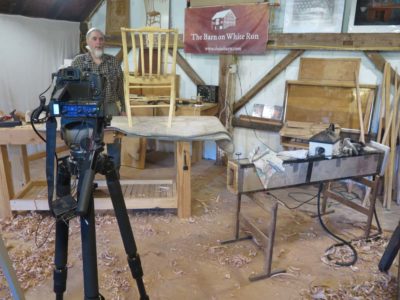
It’s been many moons since Chris and I were able to schedule some time together in the video studio as he has been overwhelmingly busy with a new full-time job, a new old house that needed a lot of work, and a new baby that was born last month in the back seat of the car while on the way to the birthing center. Plus, we’ve all been under house arrest for over three months so there is that disruption. At least my travel schedule has been light; eleven of my eleven teaching/lecturing commitments for the year were cancelled.
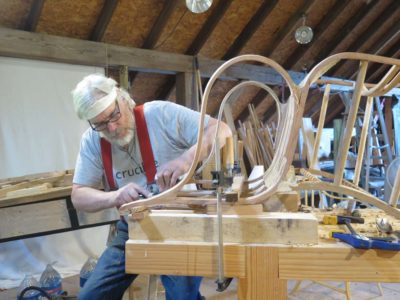
But we are back to planning some video next month, and in the mean time I am trying to wrap up chair #2 to get it delivered to a phenomenally patient client. In order to capture the final piece of the video we need I will actually start another chair and get it to that point of the filming. And, I have penciled in the week after next for my pedal-to-the-medal exercise in building a chair in five days to see if I can schedule a workshop on that project for next year. If that works out and the pandemic has run its course I might offer a Gragg Chair and a ripple molding machine workshop for next summer.
Stay tuned.
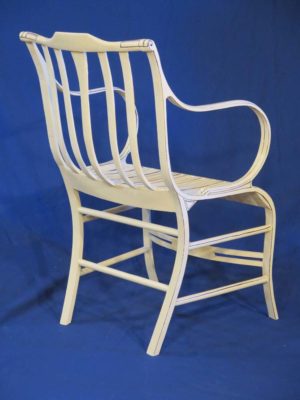
With some degree of anti-climax the pinstriping was touched-up and the final coats of satin oil varnish applied, and all of a sudden after eighteen months of intermittent labor the replica Gragg Fully Elastic Chair number MMXIX-I was finished.
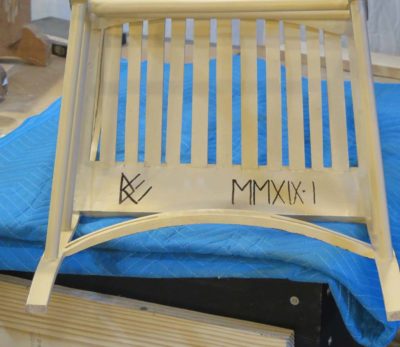
It went with me to Georgia as I traveled to FORP III, and on Wednesday delivered it to the new owner. He graciously allowed me to display it during our evening open house, and everyone who wanted was able to sit in it.
The moment of my lodging hostess giving it a test sit was captured here, being watched by FORP student Andrew and his lovely wife Katie.

With the sanding putty smoothed I concocted the top coat of paint and applied three coats of it. The base for this paint was 2 parts Zinsser oil-based primer and one part gloss Pratt and Lambert 38 varnish, tinted with yellow ochre powder pigments to match the color I wanted. The remaining historic Gragg chairs have a range of base coloration somewhere in the same zip code, and it is pretty much the chromatic neighborhood where my chairs will reside as long as I make them.
The combination of flat primer and gloss varnish yielded a nice satin surface, smooth enough for further work but with just enough tooth to hold the pinstriping and peacock feather decoration yet to come.
Stay tuned.
Now that the construction of the first Gragg chair is finished and the second one close behind, I got to thinking again, “Could I offer a workshop in building one of these?” Since I have never built one start-to-finish uninterrupted I simply do not know. Up to this point when working on these chairs I was constrained by the realities of video recording as I had to make sure my work was presented to the camera and my running commentary was comprehensible to a viewer. So, how quickly could I work without consideration of the camera nor pretending to be a friendly soliloquist?
Some time over the next couple months I am likely to find out as I undertake the making of one while “on the clock,” talking only to myself with an endless stream of criticism.
I believe that the only way to get one built in six days would be for students to start with all the necessary parts and with complete set of jigs. That is where I shall begin on some upcoming Monday morning. Then, with a time lapse camera running, I will see if I can get one constructed in five days. If I can, I would think a student could do it in six.
The workshop could not begin with a tree, as I do with the chairs I’m building, and not even with the raw riven material. Nor could it begin with steam bending all the parts, although that would be covered and demonstrated one-on-one with each student in a staggered schedule. The raw stock takes too much time to prepare for this context and the bent pieces need too much time settling down ex poste for this to be a realistic starting point so I would by necessity have all the stock prep and bending done in advance. However if it goes much faster than I am estimating I could enfold some of that by-passed content into a real syllabus.
I’m thinking my exercise will take place in late November or early December of this year. Wish me luck. If I do get the chair built in five days, working 9-6 with a lunch break, I will feel more confident in offering a six-day workshop in autumn 2020 for four students to come and build their own.
Wish me luck. I will be providing a daily update on the progress as the challenge unfolds.
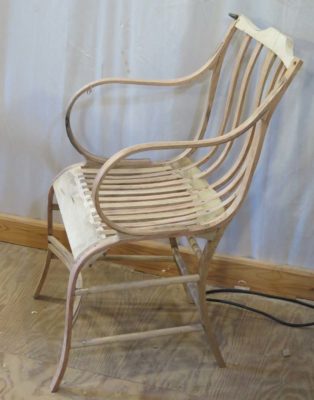
It might have been the hottest week of the summer, well over 100 degrees in the attic where I am doing all the Gragg chair project (admittedly only about 85 outside) but finally the construction is complete. Now it was time to move on to sculpting all the edges and profiles of the elements.
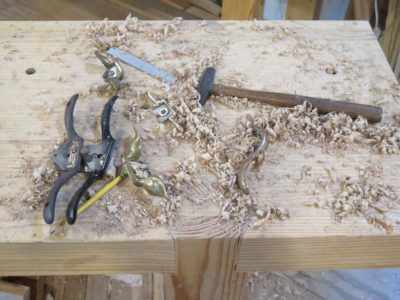
Virtually every single component was ovalled, tapered, smoothed, and shaped to add the elegance that this chair deserved. Even in its raw state immediately after final assembly it is a thing of beauty, after a the surfaces are sculpted it is sublime. The primary weapon for much of this process is a spokeshave, or more properly, a whole selection of spokeshaves I’ve assembled over the past 45 years. The main workhorse of the stable is the tiny patternmaker’s spokeshave I made In 1979, if I recall correctly. It is the tool closest to the hammer head. Another favorite is the “pig’s ear” spokeshave I probably got at a Martin Donnelly auction but I cannot remember precisely.

Systematically I went over every element, shaping them to be a harmonious whole.
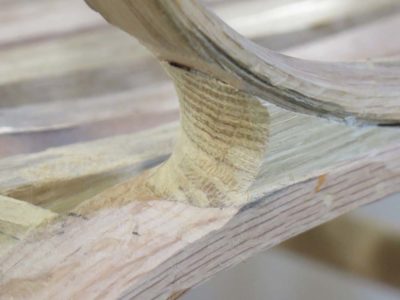
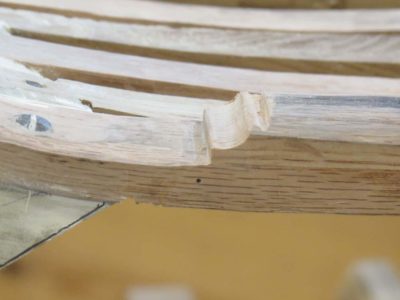
Shaping the triangular glue blocks imparted tremendous elegance, and a few final touches made it ready for paint.
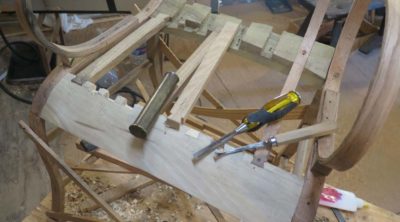
One of the challenges when building Gragg chairs is that the short seat slats are half-blind dovetailed into the front and rear seat rails (well, the front of the continuous slat are too, but it is mor difficult for these ones). As a practical matter this can only occur after the chair has been mostly assembled, so the work is in tight and awkward quarters. I generally cut the mortise shoulders of the dovetails as deeply as I can to make waste removal as easy as possible with a narrow dovetail chisel, but then I have to remove the remaining waste very carefully so as not to damage the joint fitting.
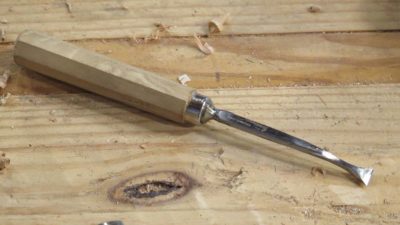
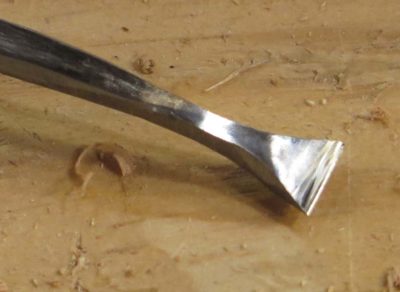
A tool that is extremely helpful in this undertaking is a custom-made curved flat fishtail gouge. I tried store-bought curved flat fishtails and although the are fine tools but they do not flare enough to be particularly useful. Instead I took a 1/2″ curved flat fishtail and ground away the shoulders to make their flare much more pronounced, and that works just fine. It allows me to reach way into the interior corners of the dovetail mortise and get them clean.
Still, it does make for a mighty long work session.
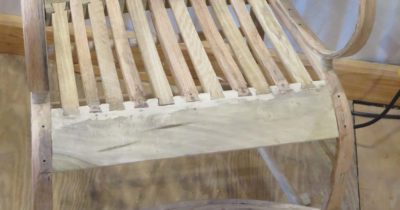
I have enough trouble keeping the joint shoulders intact without creating additional hurdles to jump. At this pint of the project that light at the end of the tunnel is getting brighter.
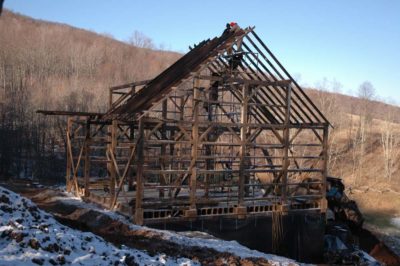
It’s been almost thirteen years since the skeleton of the barn was erected, nine years since it was outfitted with the first of more than a dozen workbenches, and over six years since the first blog post. Now safely ensconced in my 65th year, lately I’ve been contemplating the entire enterprise, reflecting on how blessed I have been and continue to be. Whether it is good news or bad news, after serious consideration I have no plans to change the fundamental structure of activity on the homestead for several more years, but at some point life in the mountains will simply become too physically taxing and the barn and cabin will be in my rear-view mirror. Until then, however, it is still full(?) speed ahead with a big smile on my face, albeit not necessarily in the exact same direction nor the exact same speed. I’m working just as hard as I did when I was 30, but the output is demonstrably less. My Mom is 102 and lucid so I’ve got to think about another forty years of engagement and productivity.
Here is a sketch of what future activities might look like. No telling if it is accurate.

Conservation Projects
Early on I maintained a fairly vibrant furniture and decorative arts conservation practice but have no plans to continue much of that except for specific projects and clients. Yes, I will continue to work with the private collection of tortoiseshell boxes that I’ve been working on for more than a decade. Recently I was approached to collaborate on a couple high profile on-site projects and if those move forward, fine. I love it but at this point I’ve got other things I want to do on the priority list. And I want to truly perfect my artificial tortoisehell. And I want to explore new uses of materials in furniture preservation. And invent new materials, or novel uses of existing materials. And, and, and…
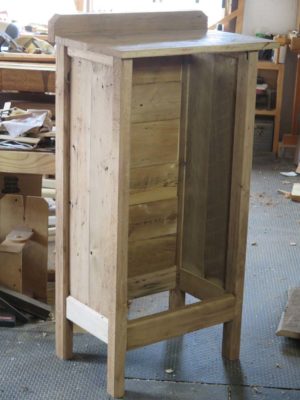
Making Furniture
I make no claim as a furniture maker of any note, but I hope to concentrate on making more in the future. I would love to maintain a small output of Gragg chairs every year, and even modify them and take them in directions Samuel Gragg never went. I also have enough vintage mahogany for eight more Daniel Webster Desks, so perhaps there are some clients who might want one. Only time will tell. I’ve always had a hankering to make some furniture in the milieu of Charles Rennie Mackintosh or Alar Aalto, so maybe that becomes part of the equation. And I have these sketches for pieces representing a collision of Roubo and Krenov while they are sitting on the porch of a Japanese temple. And Mrs. Barn has a list of things she would like for the cabin. And exploring parquetry more intensely. And finally get pretty good at woodworking in general. And, and, and…

Metal Work
I’ve always had a interest in metalworking since my boyhood when I would spend time with my Dad in his shed, melting lead weights and doing a little brazing and welding. Many of those skills have grown fallow but I am trying to get them back and take them to new places. My love of tool making has been rearing its lovely head in recent times and I have every intention of bringing that focus closer to the bullseye. And part of that has to include getting my foundry back on-line. And tuning up all my machine tools like my machinists’ lathes and mill. And getting really good at brazing and silver soldering, maybe even welding. And, and, and…
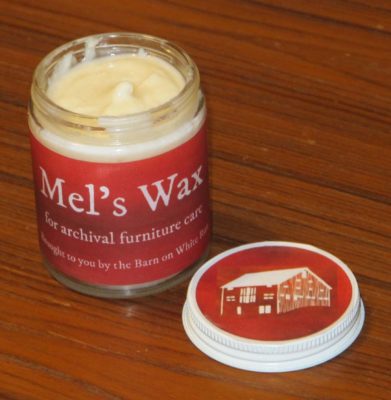
Finishing Adventures
I remain committed to looking both backwards and forwards into the realm of finishing materials, ancient and super modern. I truly believe Mel’s Wax to be a transformative furniture care and preservation product for which I have not yet discovered the key to marketing. But I will keep at it because of my knowledge of its performance and my commitment to Mel’s vision for it. And as for beeswax and shellac wax? Finishing with them may be among the oldest and simplest methods, but they can be extremely difficult and I cannot pretend to have mastered them. And what about my fascination with urushi and its non-allergenic analogs and the beautiful things I want to make from them? And what about the fifty bazillion things I do not know about shellac?And, and and…
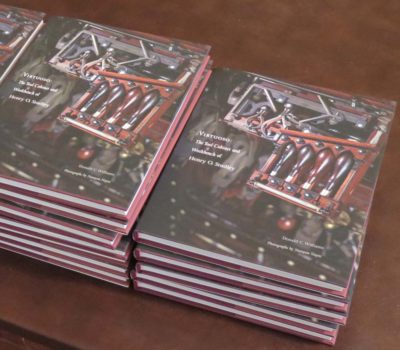
Writing
My plate of writing projects is full to overflowing, building on a strong foundation of completed works. Notwithstanding my current struggles with the manuscript for A Period Finisher’s Manual, due entirely to my having too much esoteric material to include in a reasonably consumable book (really, how much solvent thermodynamics does the typical woodworker need to know?), I enjoy every minute I am writing even when it is driving me crazy. I’d better because my collaborator Michele Pagan is one full book ahead of me in the Roubo Series. And there are two or three more volumes after that one. And some day I need to finish the almost-completed manuscript for A Furniture Conservation Primer created with a colleague while at the SI and thus will be necessarily distributed for free via the web site. And what about my treatise on the technology and preservation of ivory and tortoiseshell? And the dozen mystery/thriller novels I have already plotted out? And who knows how many short stories about the life of First Century craftsman Joshua BarJoseph? And, and, and…
Web
My first of almost 1,200 web posts went up six-and-a-half years ago, which I understand in the world of hobbyist blogging, where blogs come and go like the tides, puts me as some sort of Methuselah. But certainly not in the same class as The Accidental Woodworker, who has been blogging daily for even longer IIRC. Ralph, I tip my hat to you, sir.
I once thought the web site/blog would be a useful portal for soliloquies about my projects and things I’ve learned over a long and rewarding career, but now I am not so sure. A while back I decided to make a concerted effort to blog at least five times a week for a year, and I think I came pretty close. Surely this would increase my web traffic! Well, not so much. At the end of this effort my web traffic was 2% lower than when it began. Despite fairly consistent blogging my visitorship has dropped by almost half over the past four-plus years. So I just scratch my head. I’m not whining, but instead recognizing that the flock who is interested in my musings is shrinking, not growing. Oh well. This is not a good or bad thing, it is just a thing, helpful in me making decisions about priorities. I have no plans to really change anything about the blog, we’ll just wait and see where it goes. When I am not somewhere else, with someone else, or doing something else, I will blog.
Recently I was chatting with someone who informed me that web sites and blogs are now passe and the currency du jour is the unholy trio of Instagram, Facebook, and Twitter. Given that and my antipathy towards the latter two it is likely that I will undertake the former at some near date (yes, I know the relationship between Instagram and Stalkerbook) . Something inside me rebels at the notion of validating the post-literate world, however. Still, the economic treatise presented by Larry the Liquidator is not only dramatic but accurate. Even the Professional Refinisher’s Group is moving forward, transitioning from a moderated email forum to a private Facebook Group, which will leave me behind. But they will survive without me and I intend to maintain contact with that circle of fellowship regardless.
Trouble is, I am by temperament a bizarre mélange of buggy whip maker and hardline “emergent order” Hayekian. Hmmm. Not really sure how that works out.
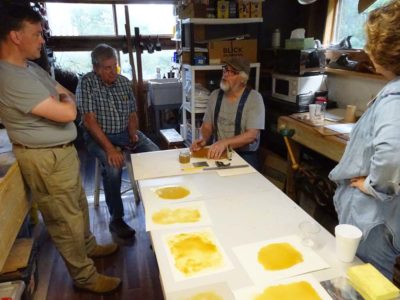
Workshops
Integral to my vision for the barn was to have it be a place of learning. As the facility was coming together, whenever I spoke to any kind of woodworking gathering the verbal response was overwhelmingly enthusiastic. The reality that unfolded was anything but. I now realize that my vision was a faulty one and the enthusiasm was superficial. Quite bluntly, almost no one wants to come to such an isolated location where local amenities are practically nonexistent, to spend a few days engaging in subjects I want to teach. Fair enough, the barn is too remote and my topics are too arcane. Like I said before, this is not a good thing or a bad thing, but just an instructive thing to add to the equation.
As a result and in recognition of reality I plan to deemphasize workshops at the barn, perhaps even eliminating them altogether, notwithstanding that I created dedicated spaces for the undertaking. Should a small group of enthusiasts approach me with the request to teach them, I will do so. That is precisely what a quartet of guys have done for next June. And, I might do an occasional blockbuster-type workshop (a Gragg chair class would be such an example, if that ever occurs; I had thought a ripple molding machine class might be such an event, but with zero response…), or I might travel a bit to teach but otherwise that part of the portfolio is likely to close. Not definitely, but likely.
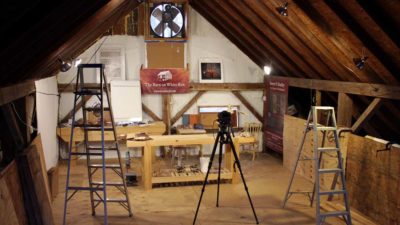
Videos
Hence my transition to teaching via video. If I cannot get folks to come here perhaps my best strategy is to go to them. I have a multitude of ideas (more than twenty full-length [>30 mins.]video concepts on the list) and a brilliant local collaborator to work with. I am committed to this path to the degree that I have the time, energy, and resources.
Further I have decided that making shorter, self-produced and thus less polished “shop technique videos” might be a useful undertaking to post on donsbarn.com, youtube or Vimeo. I will explore this avenue in the coming weeks and months.
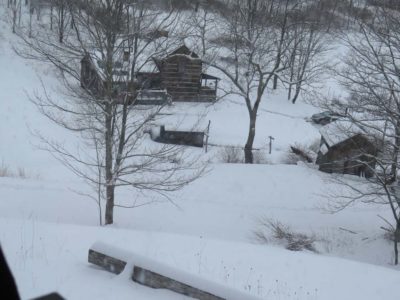
The Homestead
With several buildings, several gardens, and a power system to maintain and improve there is never a shortage of things to do here on the homestead. I want to build/expand more garden capacity for Mrs. Barn to spend time doing the thing she loves best. And fruit and nut orchards. And I want to finish creating a rifle scope for shooters like me who have lost most of the vision in their dominant eye. And another hydro turbine downstream from the current one.
And, and, and that’s all I’ve got to say on the subject.
That is The State of the Barn Address, 2019. To quote one of Mel’s favorite songs, “The future’s so bright I gotta wear shades.” Yes it is. I am living the dream.
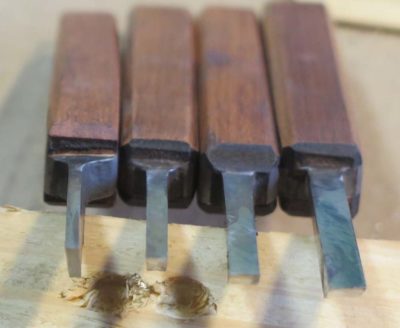
With the big push to get the Gragg chairs assembled I was inspired to finish the first of the plow plane iron mortise chisels. I got the four smallest ones to the finish line, or at least finished enough to actually use them on the delicate mortises of the chair.


The back splat elements are mortised into the crest rail with 3/16″ tenons.
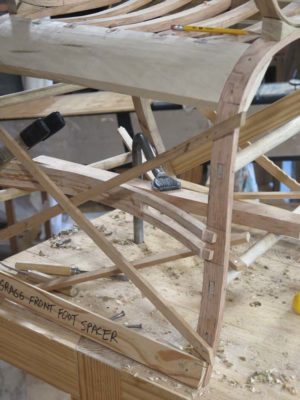
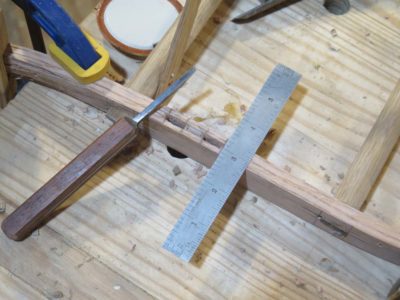
The front bowed rung is inserted into the front legs with a pair of 1/8″ mortises. These need to be accomplished fairly late in the assembly timetable so there is limited space to work. These new petite chisels (roughly 6-7″) work like a charm.

One of the important things I learned was that the striking end of the chisel is comprised of two laminae of the wood cheeks and the fairly soft steel(?)from the plow plane iron that runs the full length of the tool. I resolved this for the moment by using a brass mallet for pounding on them rather than a steel one. I will add rivets near both the top and bottom of the handle to make them more robust, and may even add a metal striking cap at the top of the handle.
But they do indeed work exactly as I had hope they would
This has been The Summer of Gragg, and I am on the home stretch for the two chairs I am building. One of the big hitches to the project is that I was committed to getting it all on video, and sometimes getting my calendar to mesh with the videographer’s calendar was a big challenge. Fortunately (?) I made sure to have the two chairs at different points of the process, making sure the have one of them at the concluding point of the previous video session and the other somewhat ahead. So, when our calendars did coincide we could make hay.

Recently the first one made it to the finish line construction-wise. I was pleased. I can now concentrate on trimming and sculpting each of the individual elements to make the chair much more sinuous. This process must be done once the chair is fully assembled so the lines, edges, and proportions can be tuned as a whole.
I’m envision a completion date of early to mid- October.
I’m guessing that we will have 20+ hours of good video when all is said and done, and for simple logistics it will have to be diced into roughly hour-long segments to get it upload-able.
In our most recent video session the Gragg chair really began to take shape as the front and rear seat rails and the crest rail tied together the sides, and the bent seat/back units were laid in place to begin that joinery.
 .
.
More to come as soon as we can synchronize our schedules.































 .
.
Recent Comments